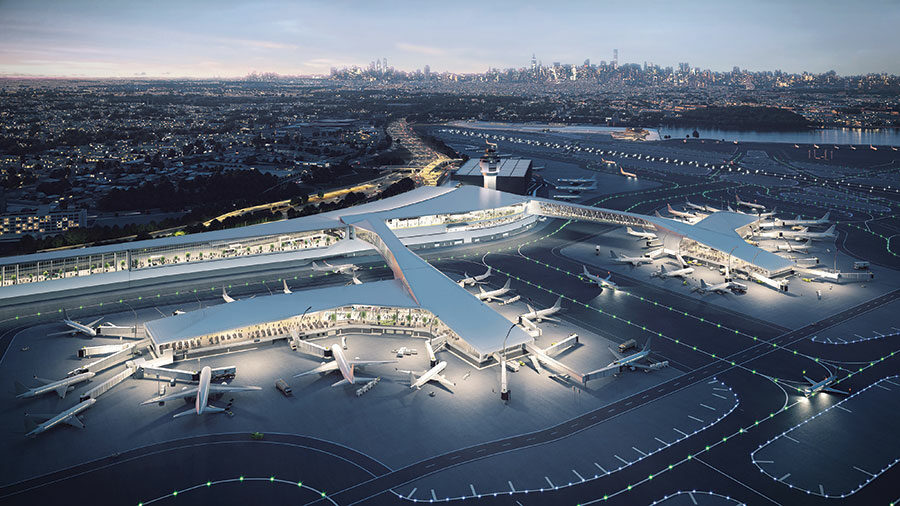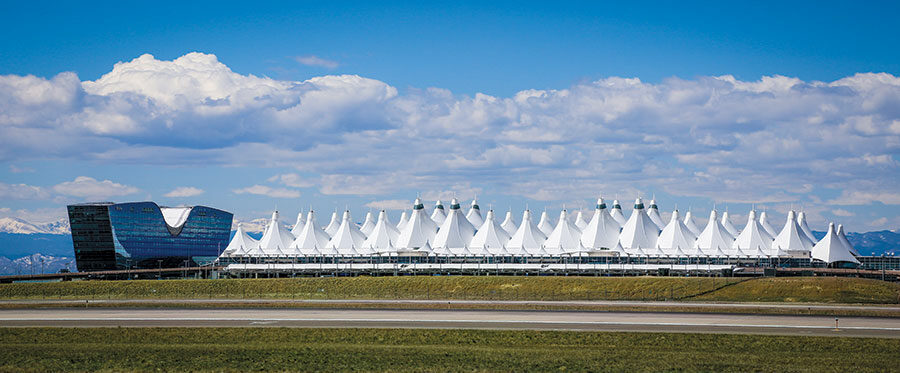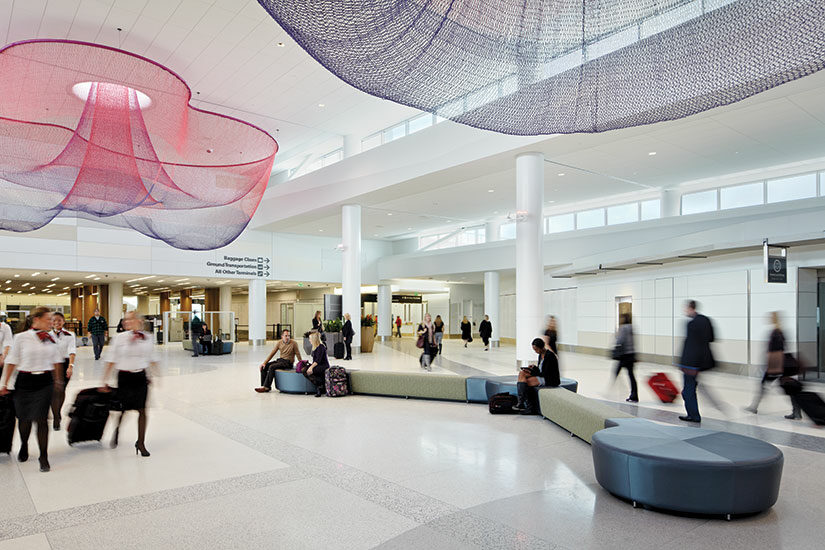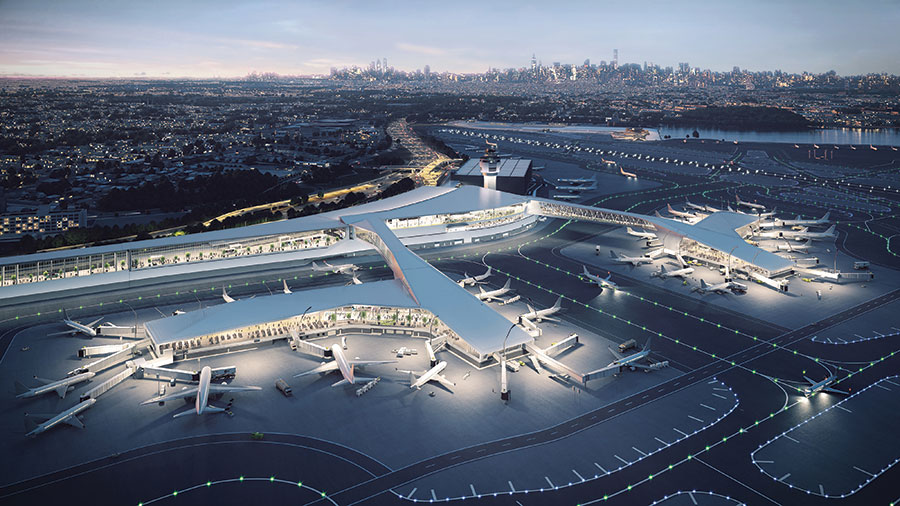U.S. Sees Rise in Airport Construction

HOK’s redevelopment of LaGuardia Airport in New York will create an interconnected facility, starting with Central Terminal B.
Photo courtesy HOK and WSP

At Denver International Airport, an outdoor public plaza sits between the Westin hotel and the peaked Jeppesen Terminal by Fentress Architects. The airport plans to add 39 new gates by 2021.
Photo courtesy Denver International Airport

As part of a 2011 renovation, Gensler designed rest areas in San Francisco International Airport’s 640,000-squarefoot Terminal 2. Bay Area artists were commissioned to create original works for the project.
Photo © Bruce Damonte, courtesy San Francisco International Airport



Architects & Firms
No matter the destination, a trip to the airport seems to land you in the same place these days—another construction site. It’s not just your luck; work on airports is surging throughout the country, and over the next three years, an estimated $70 billion will be spent to modernize aging aviation infrastructure at over 50 airports.
“These major airports have squeezed as much blood out of stone as possible,” says T.J. Schulz, president of the Airport Consultants Council. “Airport authorities and designers have done all they can to account for differing airline service trends and new technologies coming into play, and now they’re in a position where they have to either refurbish or rebuild.”
This is not a surprise; the average U.S. airport is about 40 years old, though Schulz says facilities can be rendered obsolete in even less time, thanks to rapidly changing technology and business arrangements.
The main focus of the current building boom is on terminals, where passengers’ impressions of a city and airline are made. New York’s LaGuardia Airport can be held up as a cautionary tale for what happens if airport authorities postpone desperately needed updates too long. In 2014, then-vice president Joe Biden famously singled the airport out for its crumbling structures, saying after landing at LaGuardia, “You’d think, ‘I must be in some third world country.’ ” (President Donald Trump first made a similarly phrased observation in 2011.)
LaGuardia, and most other American airports, rarely make it into international rankings of top facilities unless the sheer number of passengers are taken into account.
“We all knew Biden was right,” HOK president Carl Galioto, FAIA, said at a public presentation last month. “I used to joke, after being delayed for flights there, that I wanted to take a sledgehammer to the building.” Galioto got his wish; his firm is designing LaGuardia’s new $4 billion Central Terminal B, which began officially in 2016 as part of a public-private partnership agreement to update the whole facility. For the new Terminal C, operator Delta Air Lines directly hired Burns & McDonnell as the prime consultants with Corgan brought on as a sub-consultant to design the new building that will replace LaGuardia's current Terminals C and D. Both projects represent financial models that are becoming increasingly common, according to Schulz.
“Airports are looking more to alternative project-delivery mechanisms like design-build or public-private partnerships to divest some of the risk of these complicated projects from the public to the private sector,” he says. “We’ve also seen a noticeable uptick in airlines’ themselves funding projects—almost circumventing the airports just to maintain their facilities.”
LaGuardia’s new central terminal, expected to be completed by 2022, is being delivered by the private consortium LaGuardia Gateway Partners, to which HOK belongs. The Port Authority of New York and New Jersey hired the group to design, construct, and then operate the terminal until 2050. HOK’s 1.3 million-square-foot facility will be built adjacent to the existing 1964 terminal, which will probably continue operations until the new terminal’s completion. (Operations’ coexisting with construction is common to nearly all projects, Schulz says.)
There’s also a broader significance to Central Terminal B’s site; the architects demolished a parking structure, long an eyesore, to make way for the new building, which symbolizes the waning role of car parking and rentals at airports—a significant change that hits airport authorities’ bottom lines, according to Schulz.
“There’s research under way on what airports can do to reconstitute parking facilities into different facilities,” he says, noting that many airports have seen car-related revenues decline, despite the near doubling of congestion on airport roadways, a trend attributed to the rise of services like Uber and Lyft. But there are grounds for optimism, says Schulz: “Airports have got a lot savvier in trying to run more like businesses.”
Much of that happens inside terminals, where amenities like restaurants and retail, which are enjoyable for passengers and profitable for airports, are housed. At Denver International Airport, which is planning a $1.5 billion expansion, facilities include an outdoor plaza and seasonal beer garden, while San Francisco International Airport’s ongoing multibillion-dollar upgrades incorporate features such as specially commissioned artwork, yoga rooms, and play areas for children.
At LaGuardia, HOK’s design plays off a metaphor of islands and bridges, beginning in an expansive glass hall where concessions will be grouped on upper levels, leaving paths to the gates easily visible throughout the transparent building.
So, buckle your seat belts; there will almost certainly be turbulence ahead, but, about a decade from now, travelers can expect a smoother, much improved pre-flight experience.
Neel V. Patel contributed reporting.
Correction, May 15, 2018: An earlier version of this story mischaracterized the relationship between HOK and Delta Air Lines regarding Terminal C. Update, May 18, 2018: The firms responsible for the design of LaGuardia Airport's new Terminal C have been added.








